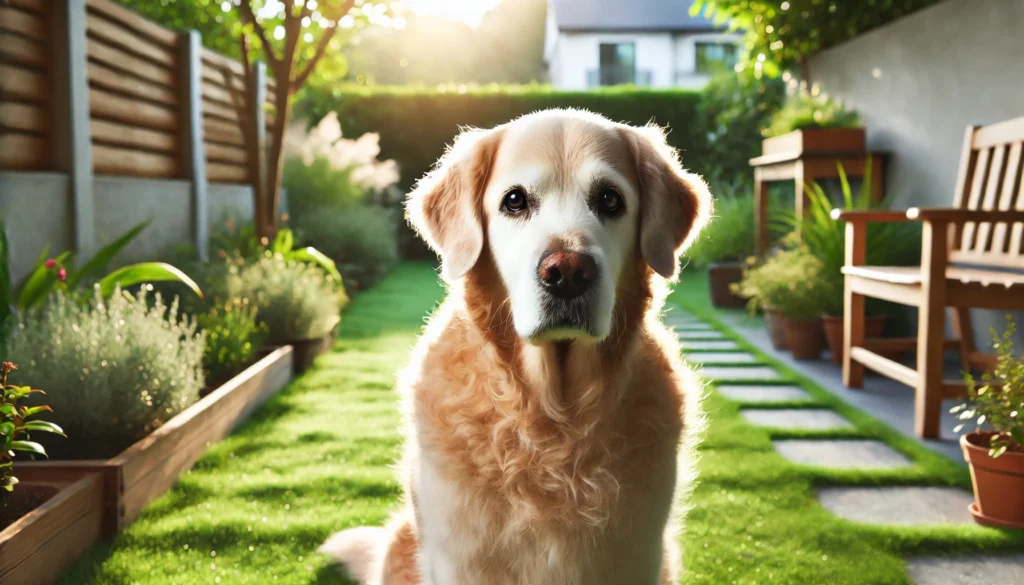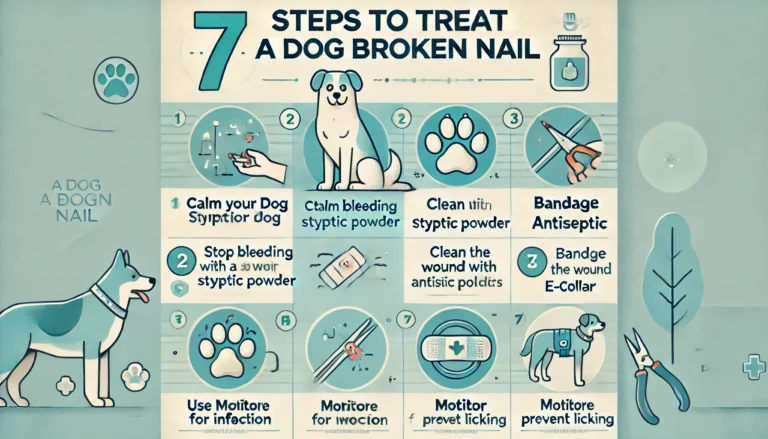7 Dementia Symptoms in Dogs

Dementia Symptoms in Dogs,as dogs age, their cognitive abilities can decline, much like humans. This condition, commonly referred to as dementia in dogs or Canine Cognitive Dysfunction (CCD), can impact a dog’s memory, awareness, and overall behavior. It’s a progressive condition that typically affects senior dogs, making it essential for pet owners to recognize the early signs and understand how to provide the best care.
7 Symptoms of Dementia in Dogs
Understanding the symptoms of dementia is essential to detect the condition early. Here are the seven key signs:
1. Disorientation and Confusion Dementia Symptoms in Dogs
Dogs with dementia often appear disoriented, even in familiar surroundings. This symptom can manifest gradually and become more pronounced over time.
Signs to Watch:
- Staring blankly at walls, floors, or into space.
- Wandering aimlessly without a clear direction.
- Getting lost in familiar places like rooms, yards, or near their bed.
- Struggling to find doors, entrances, or food and water bowls.
- Becoming confused when navigating furniture or obstacles.
How to Help:
- Avoid moving furniture or frequently changing your dog’s environment.
- Use verbal cues to guide them when they appear lost.
- Block off unsafe areas with baby gates.
- Maintain clear pathways for easy movement.
2. Changes in Sleep Patterns
A common symptom of Dementia Symptoms in Dogs is a disruption in their normal sleep cycle, including issues like sundowning, where they become more restless at night.
Signs to Watch:
- Sleeping more during the day and being awake at night.
- Pacing, whining, or appearing restless during nighttime hours.
- Barking or vocalizing excessively at night.
- Difficulty settling down to sleep.
How to Help:
- Maintain a consistent schedule for feeding, walks, and bedtime.
- Use calming tools like white noise machines or soft music.
- Provide a cozy and comfortable sleeping area.
- Discuss sleep aids like melatonin with your veterinarian if needed.
3. Loss of House Training
Dementia Symptoms in Dogs may forget their house training and start having accidents indoors. This happens because their ability to signal or remember routines declines with cognitive dysfunction.
Signs to Watch:
- Urinating or defecating in inappropriate areas of the home.
- Forgetting to indicate when they need to go outside.
- Accidents near their food, water, or sleeping area.
How to Help:
- Take your dog outside for frequent potty breaks.
- Reinforce positive habits with rewards and patience.
- Use puppy pads or designate specific indoor areas for accidents.
- Avoid punishing your dog, as this behavior is unintentional.

4. Changes in Social Behavior
Dementia Symptoms in Dogs can cause shifts in your dog’s personality, leading to changes in how they interact with family members and other pets.
Signs to Watch:
- Withdrawing or avoiding affection.
- Becoming more irritable or displaying uncharacteristic aggression.
- Appearing unresponsive when called or spoken to.
- Seeking constant attention or following you around excessively.
How to Help:
- Provide gentle interactions and respect your dog’s need for space.
- Avoid overwhelming your dog with too much noise or activity.
- Monitor interactions with children or other pets to ensure safety.
- Create a safe, quiet retreat for your dog to rest undisturbed.
5. Decreased Interest in Activities
Dementia Symptoms in Dogs may lose interest in activities they once enjoyed, such as playing with toys, going for walks, or socializing.
Signs to Watch:
- Ignoring favorite toys, games, or treats.
- Lack of excitement for walks or outdoor time.
- General lethargy and unresponsiveness to previously enjoyable activities.
How to Help:
- Encourage low-impact activities like slow, short walks.
- Use food puzzles and scent games to stimulate mental activity.
- Offer new toys or interactive games to spark interest.
- Adjust activities to your dog’s energy and comfort levels.
do you know
Constipation in dogs is a common yet often overlooked health issue that can cause considerable discomfort for your pet. When your dog is constipated, it means they are having difficulty passing stool, which can result in infrequent, dry, and hard bowel movements.
6. Increased Anxiety or Agitation
Anxiety is common in dogs with dementia, often caused by confusion, disorientation, or changes in their environment.
Signs to Watch:
- Excessive panting, pacing, or whining.
- Nervous behaviors like trembling, hiding, or compulsive licking.
- Overreacting to loud noises, sudden movements, or new situations.
How to Help:
- Use calming tools like pheromone diffusers, anxiety wraps, or calming treats.
- Stick to a predictable routine to minimize stress.
- Provide a quiet, secure environment to reduce anxiety triggers.
7. Repetitive Behaviors
Repetitive or compulsive behaviors are often linked to neurological decline Dementia Symptoms in Dogs.
Signs to Watch:
- Pacing in circles or following the same path repeatedly.
- Staring at walls or objects for extended periods.
- Licking or chewing paws excessively.
- Barking or vocalizing without reason.
How to Help:
- Redirect your dog with toys, treats, or gentle physical activity.
- Minimize triggers by keeping their environment calm.
- Monitor the frequency of repetitive behaviors and consult your veterinarian.
Managing Dementia in Dogs
While there is no cure for Dementia Symptoms in Dogs, there are steps you can take to slow its progression and improve your dog’s quality of life.
Veterinary Support Dementia Symptoms in Dogs
- Schedule regular check-ups to monitor your dog’s cognitive health.
- Ask about medications like selegiline, which may help slow cognitive decline.
Nutrition and Supplements
- Provide a diet rich in antioxidants, omega-3 fatty acids, and vitamins to support brain health.
- Consider supplements like fish oil, coconut oil, and vitamin E.
Mental and Physical Stimulation
- Engage your dog with food puzzles, interactive toys, and simple training exercises.
- Encourage short, slow walks to keep your dog physically active.
Creating a Supportive Environment
- Maintain a consistent routine to reduce confusion.
- Provide a calm, quiet space where your dog feels safe.
- Avoid making sudden changes to their environment.
Conclusion
Recognizing the symptoms of Dementia Symptoms in Dogs is crucial for early intervention and effective management. From disorientation and changes in sleep patterns to anxiety and repetitive behaviors, each symptom can impact your dog’s quality of life. By identifying these signs early, consulting with your veterinarian, and implementing supportive strategies, you can help your senior dog stay comfortable and happy. With love, patience, and care, dogs with Canine Cognitive Dysfunction can continue to enjoy life alongside their families.
What are the first signs of Dementia Symptoms in Dogs?
The early signs of dementia in dogs, also known as Canine Cognitive Dysfunction (CCD), can be subtle but are crucial for early detection. The first signs typically include disorientation or confusion in familiar surroundings. Dogs may stare blankly at walls, get lost in rooms, or struggle to find doors or their bed. Changes in sleep patterns are common, with dogs sleeping more during the day and being restless or awake at night. Dogs may also exhibit loss of house training, forgetting to signal when they need to go outside. Additionally, you may notice a decreased interest in toys, food, or family interactions. Catching these signs early allows for timely veterinary intervention and care.
Do dogs with dementia cry a lot?
Yes, Dementia Symptoms in Dogs may cry, whine, or vocalize more than usual. This behavior is often due to confusion, disorientation, or anxiety, which are common symptoms of Canine Cognitive Dysfunction. As dogs become increasingly unaware of their surroundings, they may cry out, particularly at night when their symptoms worsen (a phenomenon called sundowning). Their restlessness, combined with cognitive decline, may leave them feeling distressed. Pain or discomfort from other age-related health issues, like arthritis or vision loss, can also cause dogs to cry more. Providing a consistent routine, a calm environment, and consulting your vet for medications or calming supplements can help reduce their anxiety and vocalizations.
What is the best treatment for dogs with dementia?
While there is no cure for Dementia Symptoms in Dogs, the best treatment focuses on managing symptoms and improving quality of life. Your veterinarian may recommend medications like selegiline (Anipryl), which can help slow cognitive decline. Diet plays a critical role—foods rich in antioxidants, omega-3 fatty acids, and vitamins (such as E and B) support brain health. Supplements like fish oil, medium-chain triglycerides (MCTs), and coconut oil are also beneficial. Regular mental stimulation through puzzle toys, scent games, and light physical activity keeps their minds active. Additionally, maintaining a consistent daily routine reduces anxiety and confusion. Veterinary checkups and monitoring are essential for long-term care and adjustments to treatment.
Do dogs with dementia bark a lot?
Yes, excessive barking is a common symptom in dogs with dementia. Dogs may bark more frequently due to confusion, anxiety, or disorientation, especially in unfamiliar or dark environments. They may bark at nothing visible because their cognitive decline causes misinterpretation of their surroundings. This behavior often worsens at night during sundowning, when restlessness and confusion peak. Some dogs bark to seek attention because they feel lost or insecure. To reduce excessive barking, provide a consistent routine, dim lighting at night, and calming aids like pheromone diffusers or white noise machines. Consult your veterinarian, as medications like selegiline or anxiety treatments may help calm your dog.
What is the final stage of dog dementia?
In the final stage of dog dementia, symptoms become severe and significantly impact the dog’s daily life. Dogs often experience extreme disorientation and may fail to recognize their owners, surroundings, or routines. They may wander aimlessly, pace incessantly, or become unresponsive to commands and cues. Sleep disturbances worsen, with the dog staying awake for most of the night. Loss of bladder and bowel control becomes frequent, and dogs may stop eating or drinking due to confusion or lack of appetite. In this stage, dogs often experience heightened anxiety, restlessness, and distress. At this point, discussions with a veterinarian about quality of life and end-of-life care, including euthanasia, may become necessary.
Do dogs with dementia lick a lot?
Yes, excessive licking can be a symptom of Dementia Symptoms in Dogs. Dogs with cognitive dysfunction may lick themselves, objects, or surfaces repetitively due to anxiety, confusion, or compulsive behaviors caused by neurological decline. This repetitive behavior is often a response to stress or disorientation, as dogs may not fully process their surroundings. In some cases, excessive licking could also indicate underlying issues like gastrointestinal discomfort, allergies, or pain. If your dog with dementia is licking excessively, consult your veterinarian to rule out other causes. Providing calming tools, a predictable routine, and mental stimulation can help minimize anxiety-driven licking in dogs with dementia.
Why is dog dementia worse at night?
Dementia Symptoms in Dogs often worsens at night due to a phenomenon called sundowning, which is also observed in humans with cognitive decline. As daylight fades, dogs may experience increased confusion, restlessness, and anxiety. Their internal biological clock may become disrupted, leading to irregular sleep patterns where they sleep during the day but stay awake and pace at night. Reduced vision in dim light can further exacerbate disorientation, making dogs feel insecure and more prone to vocalizing or wandering. To help, provide soft lighting at night, maintain a consistent bedtime routine, and consider calming aids like white noise machines, pheromone diffusers, or melatonin to improve their nighttime comfort.
Is there a home remedy for dogs licking paws?
Yes, home remedies can help if your dog is licking its paws excessively, though it’s important to identify the underlying cause. Start by cleaning their paws with a gentle saline solution to remove irritants like dirt or allergens. If the paws are dry or cracked, apply coconut oil or an all-natural balm to soothe the skin. Adding omega-3 fatty acids to their diet can reduce inflammation and promote healthy skin. A warm Epsom salt soak can also relieve irritation. Ensure your dog’s environment is clean and free of allergens. If licking persists, consult a vet to rule out infections, allergies, or behavioral issues like stress or anxiety.
How long do dogs survive with Dementia Symptoms in Dogs?
The life expectancy of a dog with dementia varies depending on the severity of symptoms, their overall health, and the care they receive. Dogs with mild to moderateDementia Symptoms in Dogs can live for 2–3 years or longer with proper management, including medications, dietary supplements, and environmental adjustments. Providing mental stimulation, a consistent routine, and veterinary care can significantly improve their quality of life. In severe cases, where symptoms like disorientation, anxiety, and loss of bodily functions become unmanageable, life expectancy may be shorter. Regular monitoring and discussions with your veterinarian will help assess your dog’s quality of life and determine the best course of care.
Is dog dementia painful?
Dementia Symptoms in Dogs itself is not inherently painful, but the associated symptoms can cause discomfort or distress. Dogs may experience confusion, anxiety, and fear due to disorientation and changes in their environment. Additionally, underlying age-related health conditions like arthritis, dental disease, or organ issues can contribute to physical pain, which may exacerbate dementia symptoms. Signs of distress include pacing, whining, barking, and restlessness. To ensure your dog remains comfortable, work with a veterinarian to address any underlying health problems. Providing a safe, quiet environment and using calming tools or medications can help reduce anxiety and improve your dog’s overall well-being.






